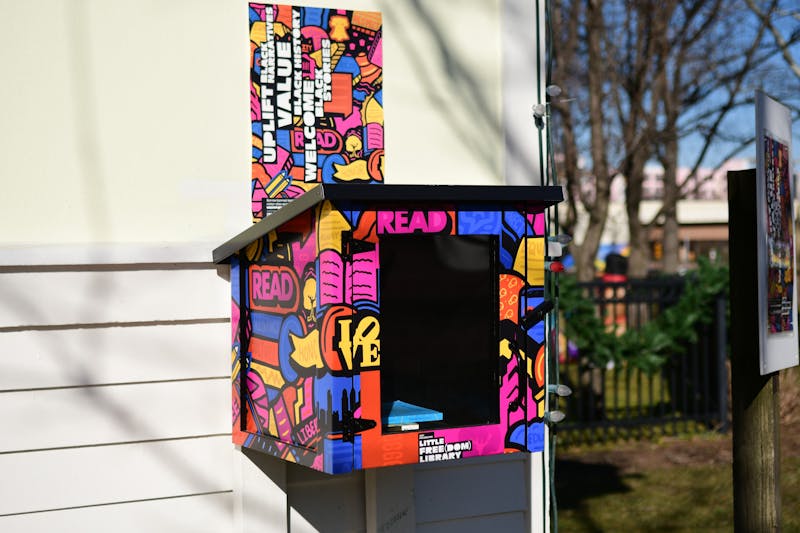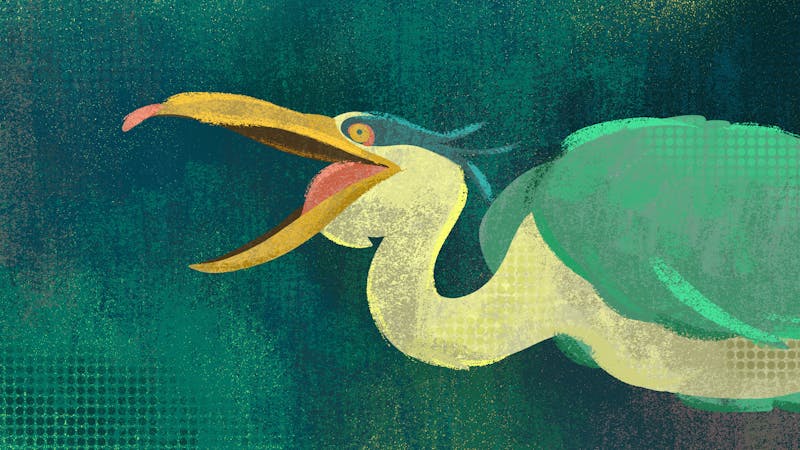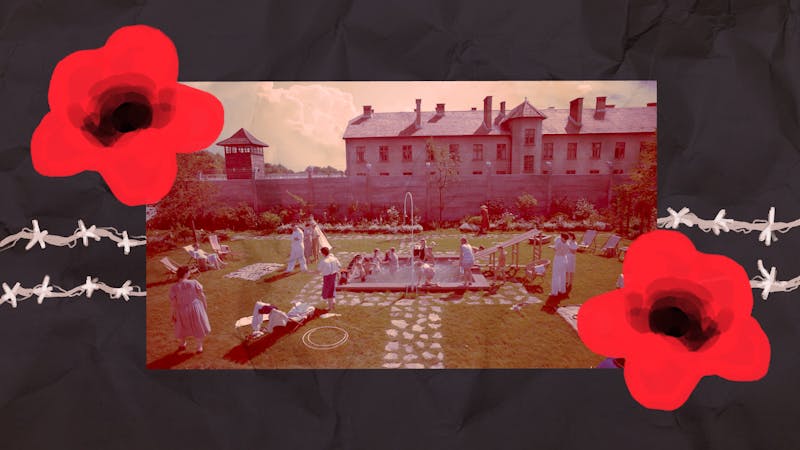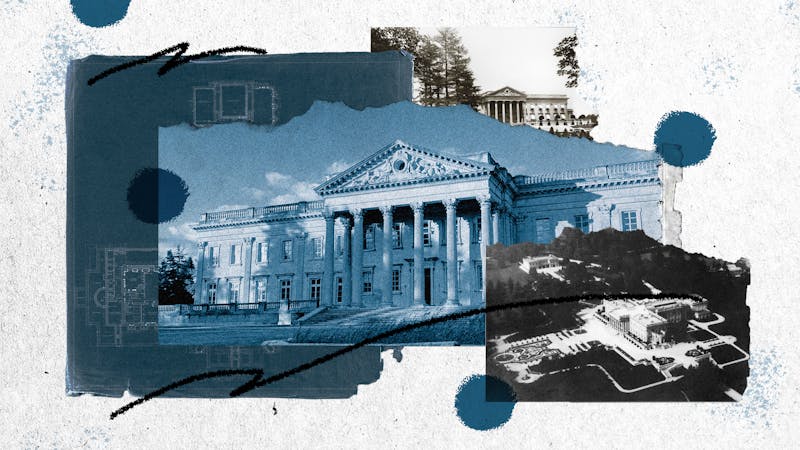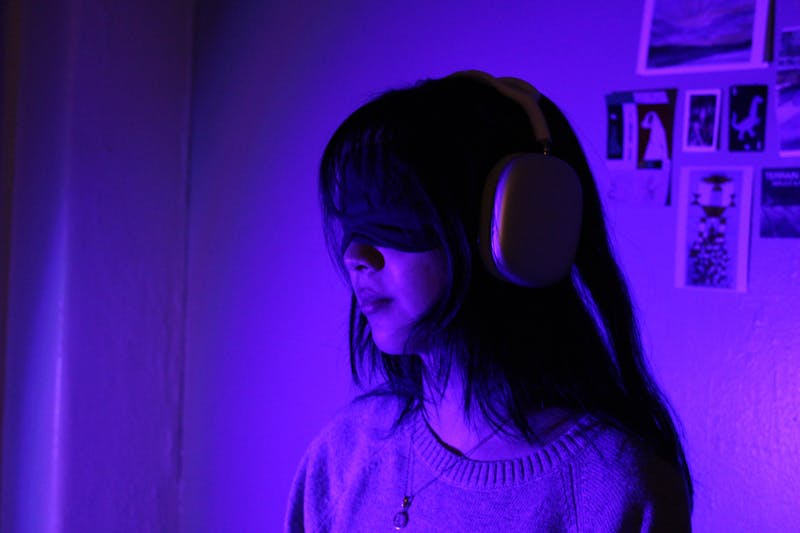When visitors walk through the main entrance of the Penn Museum, they are greeted by one of the signature items in the museum’s collection: a 13–ton granite sphinx dating from the reign of Egyptian Pharaoh Ramses II in the 13th century BCE, the largest such object in the Western Hemisphere. Next to the entrance hall lies a gallery dedicated entirely to people from a different part of the world, and one much closer to Philadelphia. Through a pair of double doors to the left of the sphinx lies an exhibition titled “Native American Voices,” dedicated to describing the past and present Indigenous communities where the U.S. and Canada now reside.
At the beginning of the gallery, a video of a fire is projected onto the floor in the center of the room, as the voices of Native American artists and activists loop overhead. Along the walls are 400 artifacts from a variety of Native American and First Nations peoples, many of which date back to the 1800s or earlier, such as an arrowhead on display from 8500 BCE. But it wasn’t until the 20th century that these artifacts were collected by the museum during University–sponsored archaeological missions, which didn’t always have the permission of local Indigenous communities.
Alongside those are more modern pieces, produced by Native American artists within the last few decades, either donated to or purchased by the Penn Museum. One piece, titled Returning Salmon, was created by Susan A. Point of the Coast Salish people, in what is now British Columbia, Canada. Made up of a wooden whorl and glass spindle, engraved with traditional iconography from the region, this work combines new and old techniques to create an exciting stylistic fusion. A bracelet, made by Ken Romero of the Taos Pueblo Tribe of New Mexico, purchased by the museum in 2002 and currently on display, is a silver band set with turquoise and coral stones; the back of it includes engravings of the artist’s name alongside images of what appears to be a rising sun.
In addition to pieces from contemporary Native American artists, the display cases feature text and images that describe issues contemporary North American Native American communities face and the strategies they employ to keep important traditions alive. The audio that plays as one looks at the exhibition is called Counternarratives, featuring the voices of Pueblo, Diné, and Tlingit artists who discuss the key role of art in maintaining their cultures.
According to Laura Hortz Stanton, the museum’s Director of Collections, the “Native American Voices” exhibition “was developed in consultation and collaboration with over 40 Native American advisors that were part of that process to help guide what would be in that gallery.” She says, “I think the wonderful part about that exhibit is it goes as the title says, in terms of Native American voices, it really reflects Native American culture, from history through today.”
Stanton emphasizes that the ongoing work regarding the exhibition is a continuous process of collaboration with the museum’s staff, a process she is proud of. She thinks this will help the Penn Museum stay relevant amid a changing landscape in the world of Native American anthropology.
Furthermore, the partnership with Native American leaders can help curators. Lucy Fowler Williams, an Associate Curator in the Penn Museum’s American section, claims that this process of collaboration can help all stakeholders involved in such a display. “It’s one thing to read about something or to write something from a distance, but it’s an entirely different understanding when an individual from that community can bring a different perspective,” she says. “Many of the things we have in the museum are old, and it’s wonderful as well to see how these older things are filling in the gaps for Native people who come and learn themselves new things.”
But for Dagny Elise Carlsson, a Native American student in Penn’s School of Design, the museum’s collection deserves to be explored instead of just sitting in a museum exhibit—or deep in storage, rarely to be seen, as the vast majority of Penn’s holdings from Indigenous communities are. Instead, she’s concerned that students who spend years at Penn could leave the school without being aware of the history of Philadelphia's original inhabitants.
“If museums are going to have anything, they might as well have it on display or available for educational purposes,” she says. “It’s a shame that many universities’ graduate students who aren’t fully aware of the history of the displacement and removal of Native peoples in North America, especially regarding how it continues to impact Indigenous groups today.”
Other museums have recently taken steps to remove their collections from public view. Recently, the Museum of Natural History in New York announced plans to close galleries dedicated to the United States’ Eastern Woodlands and Great Plains, together encompassing almost 10,000 square feet. Harvard’s Peabody Museum removed nearly 40 objects from display, and the Field Museum in Chicago covered some display cases.
This step is necessary since it has come to light that not all of the artifacts in these collections are in compliance with the Native American Grave Protection and Repatriation Act, or NAGPRA. Since its passage in 1990, NAGPRA has sought “the protection and return of Native American human remains, funerary objects, sacred objects, and objects of cultural patrimony,” according to the National Park Service. NAGPRA limits how museums can exhibit and perform research on Native American artifacts, with the wishes of the original creators’ descendants placed at the forefront of repatriation. In January 2024, the federal government doubled down on this goal. Under newly enacted regulations, museums must obtain permission from tribes before displaying artifacts, and they must repatriate human remains and funerary objects within five years.
These regulations come amidst a larger discussion about how issues surrounding heritage and items of historical and cultural significance should be addressed. Richard Leventhal is the Executive Director of the Penn Cultural Heritage Center, which aims to focus discussions on cultural heritage around social and economic contexts. He says that definitions of heritage can be very different if they come from large authorities—such as national governments or international NGOs such as UNESCO—versus allowing local groups to make those decisions for themselves. “So our model is that we want to work with communities and let communities decide both what is heritage and how to save them, the reasons for that preservation, as well as what may therefore be allowed to be changed or destroyed within their environment,” he says. “We [currently] don't necessarily allow smaller communities, and particularly Indigenous communities, or smaller countries to make those decisions.”
In this role, the Penn Cultural Heritage Center works with Indigenous communities to ensure that their rights and identities are protected and to increase their representation in museums. Furthermore, it is studying intellectually “the question of why do museums continue to acquire objects and what is the future of museums in terms of their relationship to objects, which clearly ties back into the broader frame of ethically working with communities to return objects as possible,” Leventhal said.
Beyond just impacting how museums display such objects, NAGPRA regulations coincided with a larger shift in how research on Indigenous artifacts is conducted. In the past, institutions like Penn would sponsor expeditions to collect archaeological artifacts throughout North America to build much of their collection, sometimes without the fully informed consent of local tribes. Today, however, things are different; while some researchers still conduct fieldwork, people are more cognizant of the impact research can have on affected populations.
“There are other folks who do focus almost exclusively on the archaeological record, and [of] those, probably more are relying on ongoing excavations,” Megan Kassabaum, an Assistant Professor of Anthropology and an Assistant Curator at the Penn Museum, says. However, the field is shifting away from the use of excavations and working to prioritize the use of legacy collections. Legacy collections are made up of artifacts collected in the past that have been sitting in various museums and archives yet have never been truly analyzed. She explains the benefit of this shift: “[The field is] working on those legacy collections entirely without ever conducting new archaeological investigations.”
There are downsides to only using legacy data for research projects. The Penn Museum itself holds an estimated 120,000 archaeological and 40,000 ethnographic objects from throughout North America. But these artifacts may not always provide the data or insights that researchers are trying to uncover in the 21st century. Since these materials were collected many decades—or sometimes over a century—ago, the original archaeologists were studying them with different research questions in mind.
Despite these drawbacks, there is still plenty of academic work being conducted based on legacy data sets. Kassabaum recalls a recent dissertation by a graduate student who consulted with tribes in the early stages of his research. When the tribes asked that he not conduct new excavations, he respected their wishes and instead based the entire project on legacy data.
Furthermore, this shift can also make useful artifacts more accessible to researchers, especially at the undergraduate level. “An excavation is a very long process; it takes a lot of planning, and in the timelines that undergraduates work on, they're often not able to conduct excavations for, say, an honors thesis or a term paper,” Kassabaum says.
Among most distinguished academics, the primary goal is to be more aware of the people whose pasts they are examining. The Penn Museum, among others, has been building up its collections for well over a century and is still seeing new items join its catalog via donation or purchase. Kassabaum recognizes that researchers feel an obligation to examine existing artifacts and learn everything possible from them before conducting new excavations.
As part of this shift, the Penn Museum is working towards respecting the wishes of Native American tribes and including them in the process of this research. Stanton notes that the expeditions that previously brought materials back to Penn are no longer standard practice, saying “now [museum practice] is much more working with communities, learning from them and with them, and it's not necessarily this extractive process that might have been [common] in the past.”
For Williams, education is crucial for respecting the wishes of Native American groups, and she is grateful that NAGPRA provides opportunities to teach students interested in the topic about the importance of respecting the origins of the objects that they’re studying. Beyond that, she tries to remain focused on “asking questions that are relevant to Native communities and [doing] work that can give back to them.”
Kassabaum says that it’s very common for doctoral students to continue consulting with Native American tribes throughout their research and writing process. Sometimes students will send drafts for feedback and make changes based on the information they receive.
“We've certainly seen research results that are interesting to tribes, and tribes have asked for copies of the publications and have contributed to the interpretation,” Kassabaum says. She recounts an example of a graduate student who sent a copy of his dissertation to a tribe and was asked to redact information about site locations to protect the integrity of their space. “And so he took that feedback. Now, the published version of the dissertation has the site locations redacted.”
Beyond redactions in a dissertation, Native American tribes sometimes request academic institutions to repatriate items used to facilitate studies. Many legacy collections are often poorly cataloged, and tribes aren’t fully aware of what a museum is holding until a research project is completed on those items.
Since 1990, the Penn Museum has conducted at least 30 repatriations of artifacts back to the tribes whose ancestors originally produced them. These range from a collection of wooden masks found in Alaska to a wooden bowl commonly used in prayer purchased by people on an expedition funded by a member of the museum’s Board of Overseers. Penn’s repatriation attempts occur even beyond looted and stolen objects. Even if items were collected in accordance with the laws of the time and Penn believes that they can legally continue holding an object, the university has returned it in acknowledgment of an artifact’s potentially complex legacy. This was what happened with the purchased bowl when the University returned it to the Sac & Fox tribe in 2005 in an effort to comply with “both the letter of the law and also the spirit of the law,” as Stanton puts it.
However, the largest category of objects that have been repatriated are human remains. The museum’s possession and usage of human remains have been under scrutiny; the museum held remains from the MOVE Bombing of 1985 in secret for decades, only recently returning them in 2021. Over the last three decades, the museum has repatriated remains from at least 200 individuals to tribes and organizations scattered throughout North America. This includes around 120 human remains that were excavated from Prince William Sound in Alaska and repatriated to the Chugach Alaska Corporation between 1994 and 2000. However, Williams says the work is not done. While the museum has contacted every tribe whose items are held in its collection with offers to work with them, repatriations with some tribes have not been arranged yet for a variety of logistical issues.
“From the beginning, Native people have always been interested in repatriating the remains of their ancestors, and that has been at the forefront of all communities,” says Williams. “But in my experience, not all tribes have come forward, and that’s just because they’re not quite ready yet or they have their own reasons; then they will do this when they’re ready. Until then, we’ll house the remains here with care. […] The good thing about NAGPRA is that there’s no statute of limitations.”
Despite these efforts, Penn’s past with these artifacts showcases an often–flawed history that the school as a whole has had with Native Americans. Penn’s campus sits on land known to its original inhabitants as Lenapehoking, and the Lenni–Lenape people lived in what is now Philadelphia for almost 10,000 years prior to European colonization. But this long history of habitation is often unacknowledged by students, and tacit recognition only arrived in recent decades. The school did not hire an admissions officer to recruit Native American students until 2010, had no Native American professor in the Department of Anthropology until 2011, and still does not have a Native American studies major.
For Carlsson, these issues are complicated even more by the fact that the Commonwealth of Pennsylvania doesn’t have an office to manage the affairs of Native Americans living in the state and currently does not recognize any Native American tribes. This means that there aren’t as many resources to address issues relevant to Native American communities, which makes it difficult for issues regarding this topic to be addressed on a statewide level. Furthermore, the lack of representation can also mean that different tribes—which often have different histories or cultural practices—often do not have the differentiation or autonomy with how their heritages are displayed in public, Carlsson noted.
Many of these issues came to a head in 2010, when, in response to a claim filed by the T’akdeintaan Clan from Alaska, a NAGPRA review board found that 44 objects possessed by the Penn Museum had important religious and cultural value to the T’akdeintaan people. However, Penn decided to only offer to repatriate eight objects at first. For the others, it proposed a partnership where the two groups would both own the objects: Penn could display them, and the T’akdeintaan people could use them for ceremonies. This drew the ire of some clan members, one of whom, Marlene Johnson, told The Daily Pennsylvanian in 2014 that the proposal was “not satisfactory to clan members or clan leaders—any of us.” Ultimately, the parties reached an agreement in 2017 that the objects would primarily reside in the Alaska State Museum in Juneau but that T’akdeintaan people could use them at any time.
Both Stanton and Williams emphasize that the museum is always striving to improve and that collaboration with Native American tribes is an ongoing process. Stanton doesn’t currently anticipate a need to change the “Native American Voices” gallery, but Leventhal thinks that the work of respecting local communities is an ongoing process that is nowhere near done.
“I think there’s a lot of work to be done. Even within archaeology or sort of broadly cultural heritage. There remains, I think, a sense that people oftentimes from the outside with initials after their name […] have a better sense of what important sites exist in the world or in a certain geographic area,” he says. “Other communities, including local communities, might have a very different view about objects, places, sacredness, and things that are important.”
